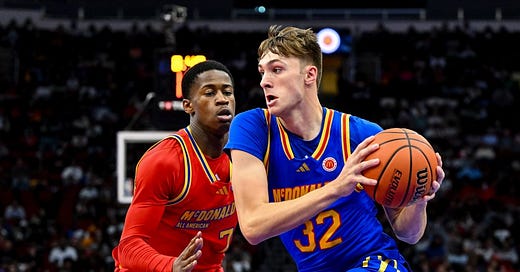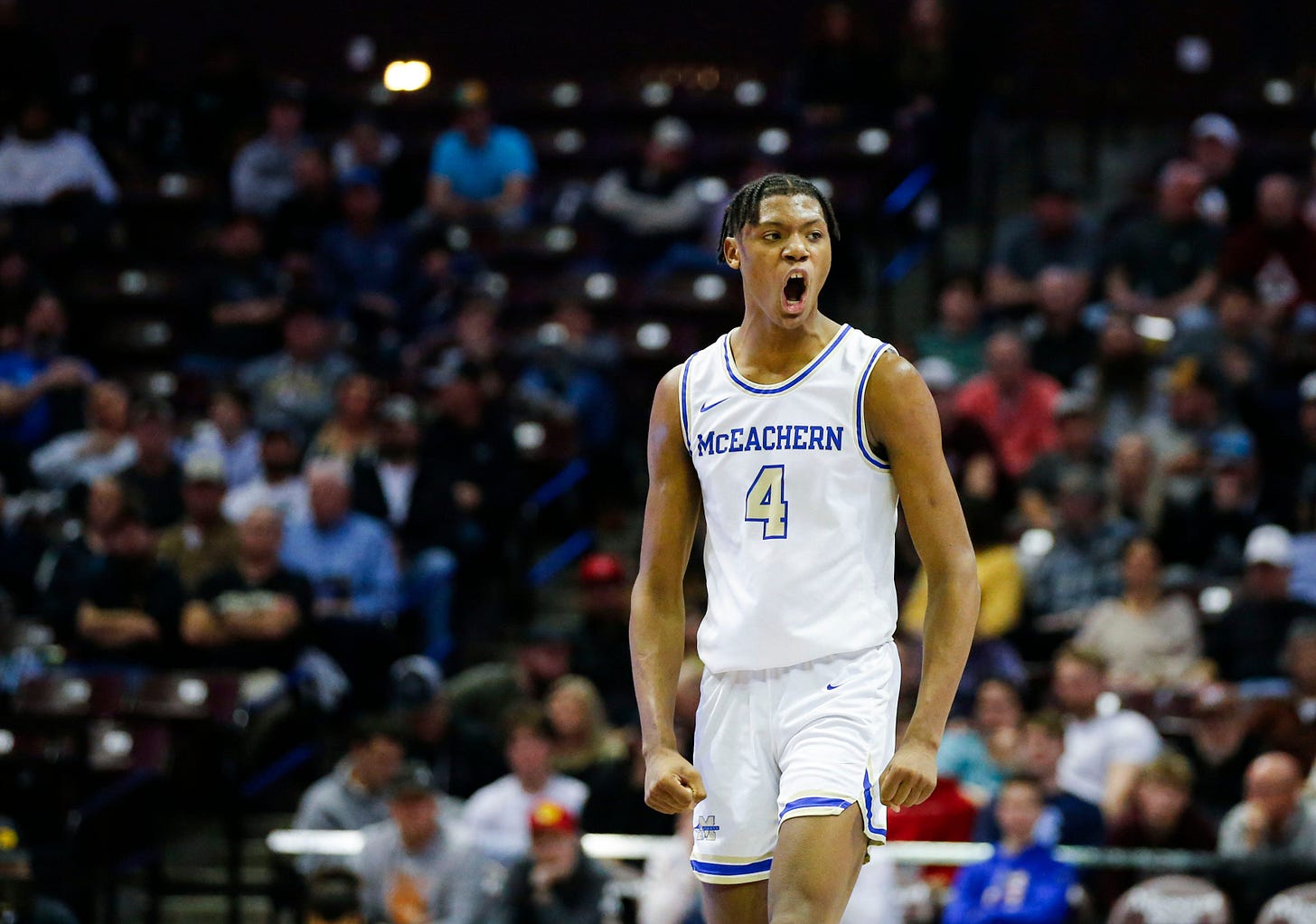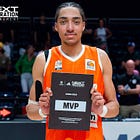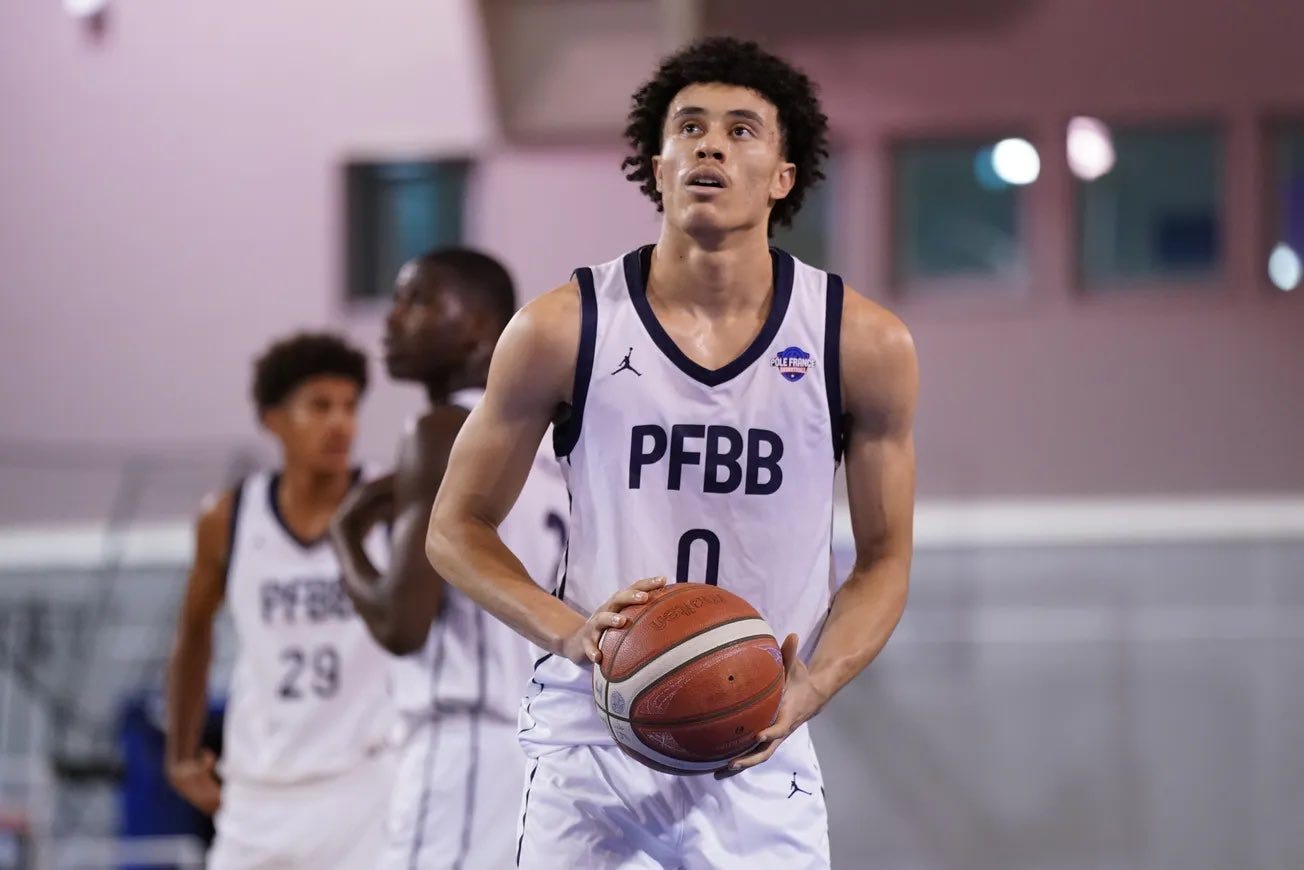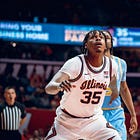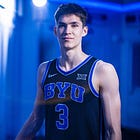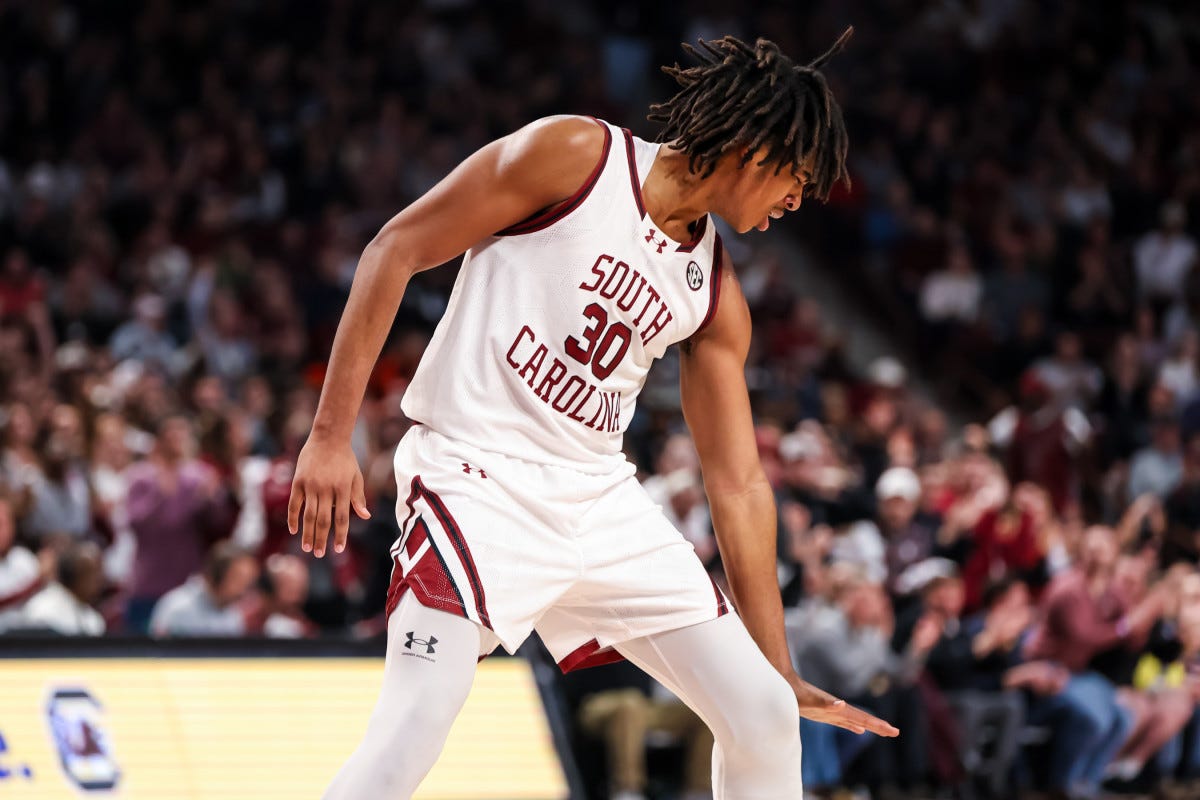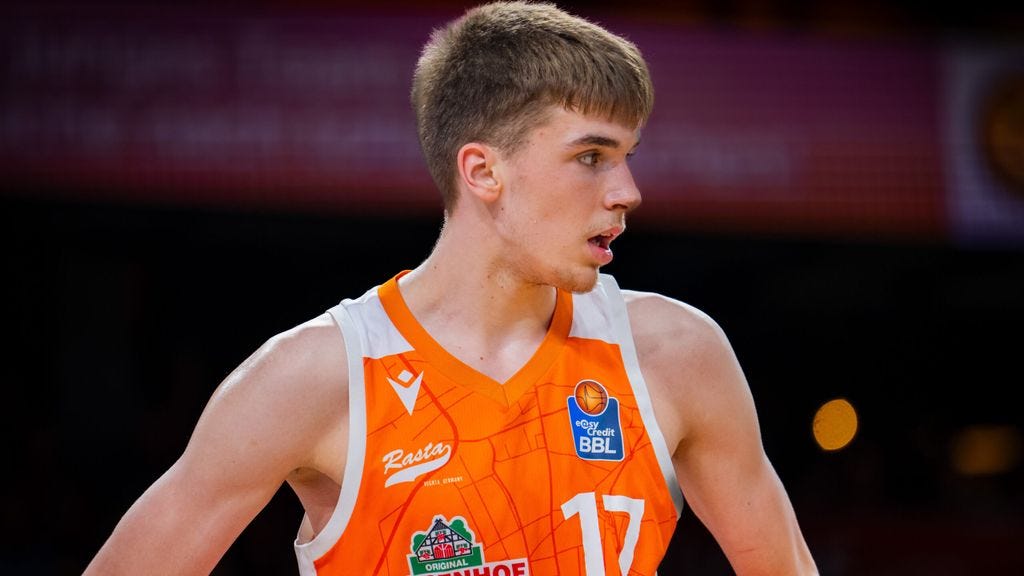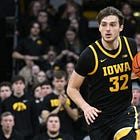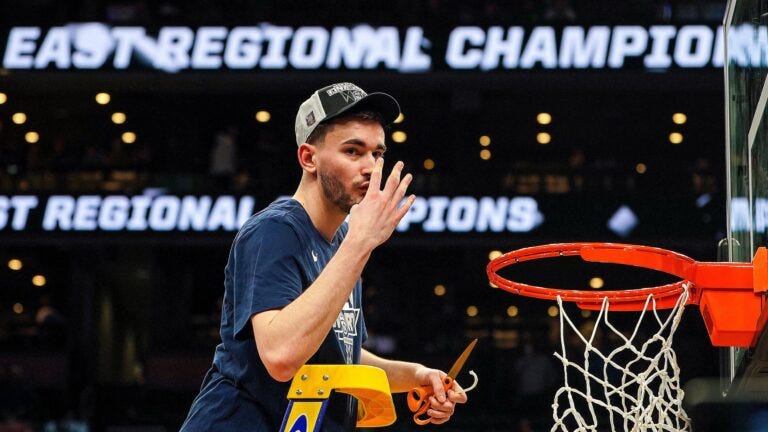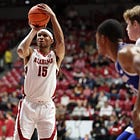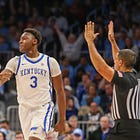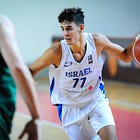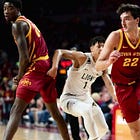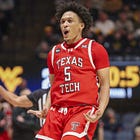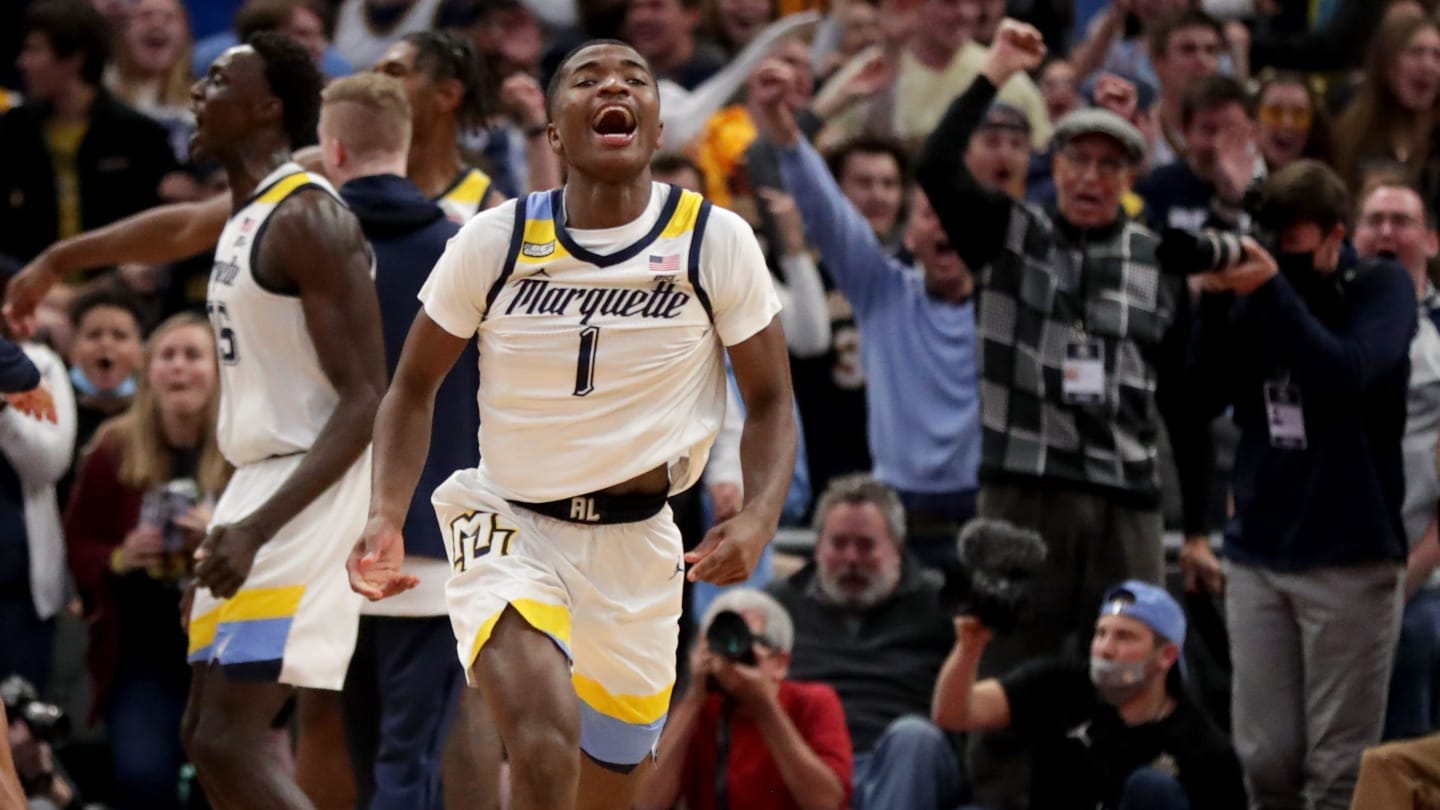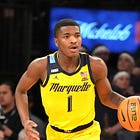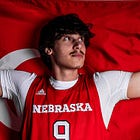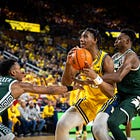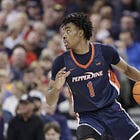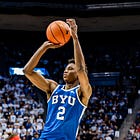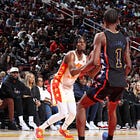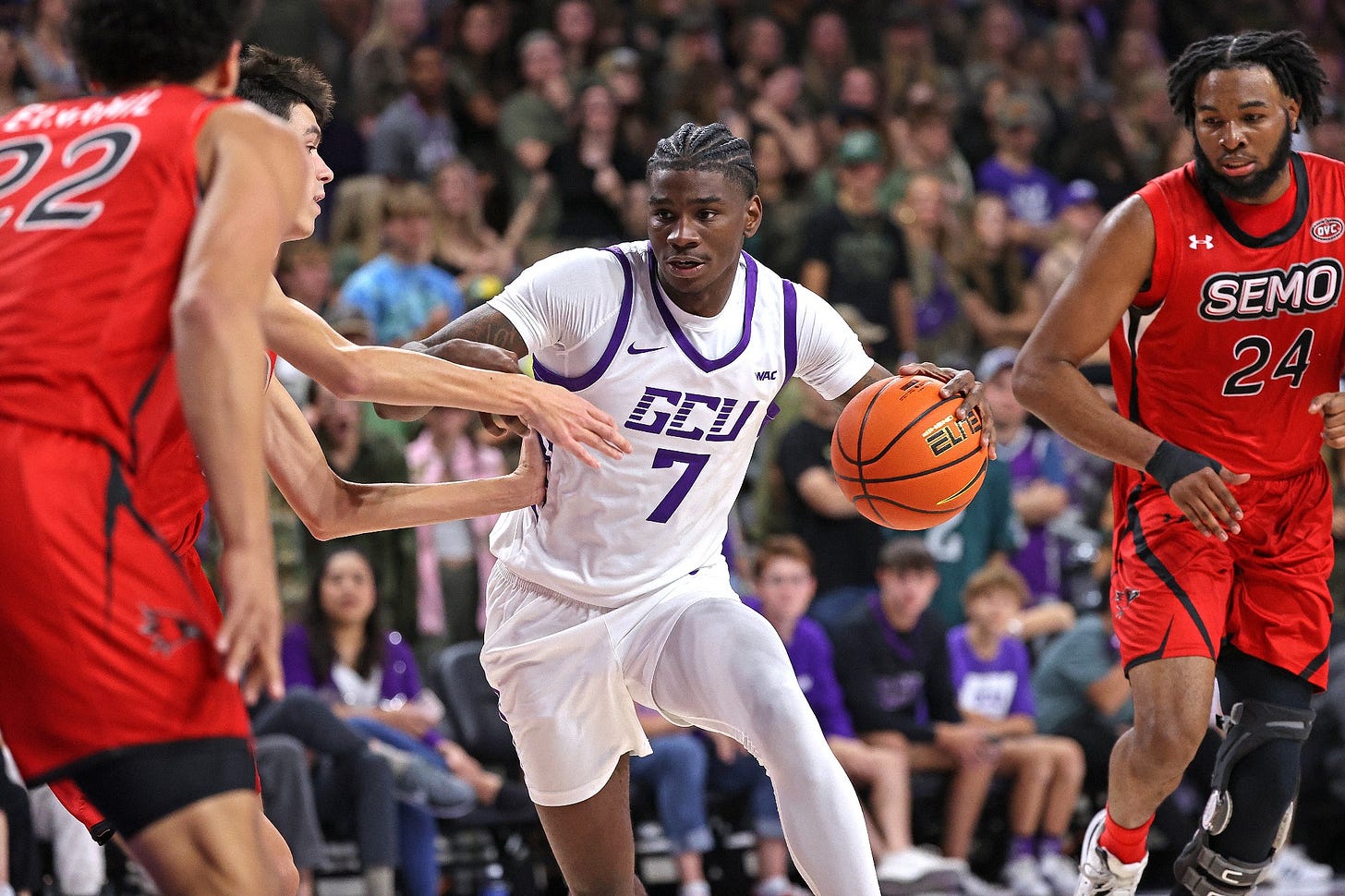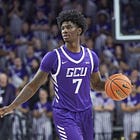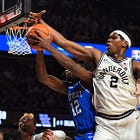2025 NBA Draft Big Board 1.0
Here we go! The first big board of 2025's draft cycle. After finalizing my film study for the incoming class while also evaluating my notes for returners, it's time for the first ranking.
Before we start, please consider subscribing. The newsletter passed the milestone of 500 subscribers! Join a group of NBA decision-makers, NBA scouts, agents, and countless draft and basketball fanatics who made this newsletter the go-to for quality, in-depth scouting reports on the less-heralded prospects. That is my M.O. and promise.
As a limited-time offer, I am giving a discount of 25% for life, which makes it less than three bucks a month for lots of in-depth scouting reports and other various types of content I am working on. So far, My track record has over 300K+ words written on more than 80 scouting reports for the 2024 NBA Draft. I am going to exceed that for this year’s class!
How is my Big Board built up?
With many draft philosophies out there, it’s vital to understand why I rank prospects the way I do. With recency and consensus bias being a part of how draft content is consumed, it doesn’t always benefit the overall quality of draft coverage. That’s why I aim to do things differently.
Therefore, I feel obligated to mention that consensus-thinkers won’t be entertained by my selections. I base my picks on a combination of what NBA front offices look for in archetypes, specific skillsets, realistic untapped potential, and the NBA role the prospect in question is projected to fulfill in the long run. The long-term impact of a prospect on a team’s defensive and offensive rating is always a part of my evaluation.
The First Round
#1 — Cooper Flagg, Duke (FR.)
Without any doubt the top guy in this class. There isn’t much reason to go into detail, but to summarize: Flagg is a generational defender who matured his game at a young age. He’s fundamentally one of the top players in this class, on top of his scoring from all three levels.
That’s the type of player an NBA franchise would be willing to give limitless ball touches, and to take the most out of his potential, Flagg has to be a team’s de facto number one option.
#2 — V.J. Edgecombe, Baylor (FR.)
His draft stock skyrocketed after his stellar performances with the Bahamas in their fight to qualify for the Olympic Games. He seamlessly played alongside seasoned NBA veterans while putting his scoring prowess on display by utilizing his elite athletic tools. That’s the area that will earn him a reputation as a 20-point-plus scorer in the league.
On top of that, his feel for the game immediately stood out, making the right decisions as a team defender in rotations. He’s a switchable defender at 6’5” who’s set to defend against all guards and wings, especially if he continues to fill his frame in the next few years.
Edgecombe’s NBA role will be to potentially serve as a number-one scoring option who increases his usage from a role as a slasher and spot-up shooter to a self-creating scorer who can also set others up. After Flagg, he’s the safest bet to be a multi-time All-Star while earning future All-NBA selections.
#3 — Tre Johnson, Texas (FR.)
Johnson has serious star potential but has to improve his fundamentals and footwork. He can end up as an automatic paint touch in the NBA if he improves the decision-making on his drives. As a master in changing pace, Johnson’s pull-up shooting game from the midrange has given him a reputation as one of the top talents from Texas in the last few years.
The biggest swing skill for Johnson is improving as a decision-maker on live-dribble passes. He’s an excellent ball handler with the offensive creativity to match but often gets caught with tunnel vision while being too comfortable in bailing defenses out with his midrange shot-making habits.
Therefore, improving his footwork to use his athletic tools much better when attacking the rim, combined with his decision-making on-ball are the two main ingredients to warrant a top-5 selection in this loaded class.
#4 — Dink Pate, Capitanes de Ciudad de México (2006)
Despite an overload of guard talent in the NBA, Pate offers the unique blend of natural playmaking skills, plus size at 6-foot-8 while having an all-rounded offensive game. As a 17-year-old, Pate has shown that he can handle the physicality of professional basketball in the second stage of last year’s G League season.
Pate continues to get his reps at the highest level, this time playing for a team that’s aiming to win a G League title. What sets Pate apart from his peers is the combination of well-improving live-dribble decision-making while offering a blend of great athleticism that can elevate his scoring to all three levels. Pate’s biggest improvement is his footwork, opening up a path to maximize how he utilizes his burst.
If everything clicks, Pate can end up as a paint-touch-generating floor general who can carry a large chunk of his team’s scoring load. That’s the key to earning many ball touches and high usages on an NBA floor.
#5 — Dylan Harper, Rutgers (FR.)
There are very few prospects in this class with a better feel for the game than Harper. He’s the son of a five-time NBA champion Ron Harper, and what immediately stands out in Dylan’s game is his combination of size, strength, and the natural process of how he sees the game. His quick decision-making as a passer, while showing the ability to get downhill both on craft and by using his strength. He’s a very good finisher at the rim, with a combination of creativity and soft touch.
For spacing purposes, leading guards have to be able to hit open threes on an NBA floor to get the angles to attack the interior, both as a scorer and a passer. That’s the area of development for Harper, who’s not a good three-point shooter yet based on the numbers and his overall shot mechanics. Therefore, for his evaluation, the effectiveness of his shots off the catch is the most vital.
The numbers are irrelevant, the key area of development for Harper is to improve his footwork when getting to his shot, as the mechanics itself need consistency. That’s why it’s likely we’ll see a volume three-point shooting season at Rutgers.
#6 — Ace Bailey, Rutgers (FR.)
I’m a big fan of Bailey’s game. However, there are key areas where his style of play might not translate on an NBA floor. Decision-making is a big part of how I evaluate talent. That’s where Bailey is losing draft value early on in the cycle. He’s consistently bailing defenses out by settling for tough midrange jumpers. While he’s able to attack the rim at will, the habit of pulling up and shooting over defenders at his size is what he prefers.
There’s a difference between having tough shots as a last resort or preferring those shots. It’s the latter with Bailey. And that’s what an NBA defense will prefer every day of the week. The more I watch Bailey, the more I see a lack of fundamentals and decision-making to work on. If he improves on that end, Bailey can be the one challenging Flagg to dethrone him from the number one spot. However, that’s a big challenge to overcome in one season. Regardless, being the sixth-best prospect in a loaded class should be a welcoming thought for one of this year’s most tantalizing prospects.
#7 — Drake Powell, North Carolina (FR.)
Powell already made his parents the proudest mother and father in the world, who both are Tar Heel alumni, while also having family ties to Coach Davis himself. Regardless, Powell will earn his starting role for North Carolina based on his basketball qualities. He has a great physical profile of a well-filled frame, good upper body strength, and broad shoulders. With very good defensive footwork, Powell can guard up to four positions in college. His defense will be his calling card and route to play good starting minutes.
On top of that, he has a silky smooth jumper that will translate to serving as a slasher and spot-up shooter early on in his freshman year. He has decent handles, but not much creativity. The bucket-getter relies on his strength to get to the basket, and in a college basketball game that is becoming older and older, it will help him to solidify himself against older athletes. Powell has a high floor for the NBA as he can potentially serve as a fifth starter right out of the gates. The top-10 potential is being shown in the long-term potential of his scoring, as improving his handles while solidifying his pull-up jumper are the main two areas to work on during his freshman season.
#8 — Khaman Maluach, Duke (FR.)
You don’t often see a utility player being a top-ten pick. However, in Maluach’s case, his tantalizing physical tools contain his fluid hip mobility and excellent verticality. He’s a very good rebounder who expanded his range to three-point territory. Maluach has a consistent shooting form that needs work, but regardless of his size, he’s good at moving without the ball, improving his perimeter game. The NBA is changing, and four and even five-out schemes are becoming more vital.
That increases the importance of floor-stretching big men who can anchor an interior when needed. That’s Maluach’s game. Despite him being a utility player, he’s a vital building block to change a good team to potentially a great championship-contending team. The most vital area of development for him is to improve as a passer and decision-maker with the ball in his hands. If he can evolve into a reliable ball-mover, it will open up the entry passes he will get on an NBA floor, and that will make him more dangerous as a three-point shooter, which is currently his only NBA-translatable trait on offense.
#9 — Noa Essengue, ratiopharm Ulm (2006)
Essengue has all the tools to be a high-end scoring wing in the NBA. Compared to his peers, he might need to most time to develop into a starter. However, that doesn’t take away much of his draft value as his complete package of tools and physical traits give NBA decision-makers an almost blank blueprint that they can fill in as they wish.
At times, Essengue doesn’t show the best body language. He can play carelessly and often struggles to adjust to a faster-paced game. In terms of his team defense, that’s the main area of development. However, to support the claim of his future improvement, he’s already a consistent shooter in terms of motion and mechanics. Has shown the ability to keep the ball high on catch-and-shoot attempts. That can make him an effective shooter off the catch in a faster-paced NBA game. That’s the base.
He’s tough, aggressive, and looks to execute reads quickly. His game is built for a faster NBA game. His archetype as a plus-sized wing, that’s what will lead to a higher draft value. Essengue uses his footwork well to impact the defense. Combined with his good passing, he can be an all-around wing in his prime, impacting the game with his production. To solidify his top-ten status, his body language and team defense need to improve on top of the need to strengthen in the next few years.
#10 — Joson Sanon, Arizona State (FR.)
Sanon is the most complete scoring guard in this class. At 6-foot-5 he has excellent positional size to serve both as a leading and combo guard. What immediately stood out was the excellent elevation of his jumpers. He’s a maestro in changing his pace and that’s the base for his scoring. Sanon is a creative scorer who uses flair, craft, and great burst to create separation from defenders. He can pull up from everyone on the floor, where he’s more comfortable to serve as a pull-up three-point shooter.
The soon-to-be Sun Devil is an improving playmaker, which is the biggest area of development. At times, he can be too selfish looking to chase his buckets rather than setting up others. However, I expect Coach Hurley and his staff to continue to use Sanon as a scoring guard, where his ability to play as a ball-mover will be a crucial aspect of his development. Sanon looks like he can average double-digit points in the NBA as of today, but needs to put things together as a creator for others to fully bank on his potential.
#11 — Nolan Traoré, Saint-Quentin (2006)
Traoré is a classic European guard with a modern NBA touch. He’s a very creative ball handler who masters angle creation by using his craft and footwork. He’s not an explosive athlete but looks to deceive defenders by utilizing his footwork to perfection. The reason why he falls outside of my top 10 is the lack of size combined with the need to get stronger in the next few years.
He struggles to consistently defend against non-guards, which will be the case on a nightly basis on an NBA floor. On top of that, to make it work, he needs the ball in his hands. A lot. Compared to the aforementioned leading guards, Traoré doesn’t have the same promise as a three-point shooter, which will eventually hurt the biggest value he has as a scorer.
Despite the lack of explosiveness, Traoré will always get to the rim relying on his creativity, change of pace, and craft. However, without much of a threat from three-point land, it will toughen the ability to solidify himself as an interior scorer. That combined with the ball-dominant character of his game, NBA decision-makers will be hesitant to give him the ball touches and usage to help him develop into a starting-caliber point guard. Regardless, Traoré is a top-ten-level prospect who can change his draft stock to the positive by showing that he can be a consistent pull-up shooter from three while improving off the catch.
#12 — Will Riley, Illinois (FR.)
At 6-foot-9, Riley can impact a team on both ends. He has a combination of great foot speed, mobility, and burst which opens up to be an impactful defender in the future. However, the main context around his development will be filling his frame in the next few years. Riley is still growing, and often a prospect’s frame needs time to adjust to the extra inches. In terms of playing time, his number will often be called by Coach Underwood.
Illinois lost key starters to the NBA, transfer portal, and graduation. Therefore, the door to play starter minutes is there for Riley, who’ll be one of the main scorers of the team. He’s a terrific scorer, especially near the rim. His combination of fluidity, creativity, and size make him a threat at scoring from the inside and out.
The biggest area of development is to translate the added size and length to his shooting. Understandably, Riley isn’t a consistent shooter yet. He’ll be one of the prospects whose three-point shooting numbers will be less relevant, mainly due to how quickly his body has been changing in the last few years. Therefore, the process of his jumper and his footwork will be the main two swing skills that can potentially make him a lottery pick on draft night.
#13 — Amier Ali, Arizona State (FR.)
As a plus-sized ball handler at 6’8”, Ali has been clear throughout his high school career that his best position is as a point guard. His handles aren’t tight enough yet, mostly due to a limited amount of in-game reps as a team’s de facto guard. Arizona State has filled its roster with intriguing guard talent who will get runway to play key minutes in the Big 12. Ali is a smooth shooter, especially off the catch. On top of that, he has big and quick hands that can help him to impact the game as a team defender. His understanding of rotations opens up the rest of his potential defensive impact.
His footwork is improving. Looking at the excellent size, length, and quickness of his hands, he has the tools to be a promising point-of-attack defender in the future. Especially considering how strong he is at a young age. As a consistent shooter, the pathway to more ball touches is there, but for Ali to solidify his status as a potential lottery pick, he has to show that his offensive creativity improves in his freshman year, while being able to handle the physicality of playing against older athletes.
#14 — Amani Hansberry, West Virginia (SO.)
I’ve been raving about Hansberry for two years now. From all prospects in the last few years, he’s at the top of the amount of high school films I have watched. While he was originally recruited by Chester Frazier for Illinois, he followed his mentor to West Virginia, where he had the chance to be a starter for Coach DeVries who entered his first year in the Big 12.
The four is the most crucial position in the modern NBA. Being able to handle the ball, make quick decisions off and on the ball, and being able to utilize physicality and angle creation as a scorer are must-haves to succeed. Hansberry is a mobile five who can also serve as a four due to his quick feet and great footwork. His physicality makes it easy for him to match his level of strength against older college centers. But he’s the best as a passer. Whether it’s as a ball-mover on the perimeter or making quick decisions after entry passes in the post, Hansberry can ensure a team’s offensive pace while keeping the ball moving.
He’s a two-handed finisher at the rim and has a variety of ways to score. With smooth footwork, he creates angles seamlessly. His offensive potential is fueled even more with a reliable three-point shot in his arsenal. Despite the small sample size, the consistency in his jumper goes back to his high school days. Hansberry is the best-kept secret among returners in this draft as a clear candidate to be a lottery pick in June 2025.
#15 — Egor Demin, Brigham Young (FR.)
At 6-foot-9, Demin’s biggest USP for the NBA is his combination of pick-and-roll playmaking and consistent three-point shooting. As one of the top prospects in Real Madrid’s youth setup, Demin was not given the full runway to develop him in the best way possible. He was often not allowed to lead a team in ball touches or importance. Regardless, it speaks to Demin’s work ethic that he accepted his fate and proved himself as a reliable complementary piece.
After putting himself on display in various youth tournaments, with the Adidas Next Generation being the most prestigious one, it opened up the door to play college basketball at a high major where he, more importantly, could be put in a position to lead the team.
Size, versatility, and quick decision-making are three elements that can give Demin a long NBA career. His consistent three-point shooting opens up his game in terms of footwork and process. His offensive creativity is the biggest swing skill that can put him even higher on boards, as an NBA decision-maker needs prolific scoring potential to ensure that they can give him the much-needed touches in the NBA.
Regardless of that happening, Demin will have a high floor as a versatile perimeter-defending shooter who can potentially guard against forwards in the NBA when filling his frame in the next few years.
#16 — Collin Murray-Boyles, South Carolina (SO.)
Murray-Boyles is in an interesting position. He’s been put in a box as a non-shooting undersized forward but can be seen as one of the more unique prospects of the last few years with a game that’s built to play four or five-out basketball.
Some NBA players can succeed without shooting, and he’s one of them. He has a tremendous physical profile. Stands out both with his mobility (hips, lateral quickness) and toughness (strong frame, broad shoulders, and aggressive style of play). That’s what NBA decision-makers look for to make it feasible a prospect will offer the same amount of physicality against NBA-caliber big men while switching to smaller and quicker guards and wings.
Offers great defensive versatility by guarding both roll men and ball handlers in the pick-and-roll, while being able to switch to all positions when defending off the ball. The only area of development here is to not overhelp on the defensive end, leading to late rotations. Despite being a non-shooter, Murray-Boyles shows incredible efficiency near the rim.
The role I see for Murray-Boyles is as a team-connecting four who can produce his points as an active cutter and face-up scorer. His passing is one of the best traits in potential, but he has to figure out a healthy balance of chasing his baskets and creating for others. There were many cases of him passing up on open three-pointers to force tough two-pointers instead. From an analytical standpoint, that’s a potential red flag for NBA decision-makers.
#17 — Liam McNeeley, Connecticut (FR.)
When looking for prospects with a high floor and specific untapped potential, McNeeley is among the top. He’s one of the top shooters in this class with the potential to evolve into a two-level scorer after utilizing the most out of his solid athleticism. He has a great physical profile with broad shoulders, a well-filled frame, and great upper-leg strength. That helps him to fluidly move his hips, and potentially serve as a point-of-attack defender on an NBA floor. When considering that he’s built to play as a three and a four, that’s a big trait that will intrigue NBA decision-makers.
He’s an effective finisher at the rim but struggles to get downhill when he cannot rely on his physicality. In college basketball, that will be his challenge. Coach Hurley will use him as a specific part of their system, thus making it likely he has to sacrifice some of the things he can do to fit in at college basketball’s hottest team of the last few years. Knowing that NBA scouts value high school film, the emphasis to solidify his status as a top-20 pick will be mainly on production combined with defensive impacts. McNeeley is a high-floor prospect who can develop into a niche and be one of the favorites to earn at least two contract extensions throughout his NBA career.
#18 — Michael Ruzic, Joventut Badalona (2006)
Ruzic fits the mold of the floor-spacing four who leverages his shot to open up the rest of his offense. Looking at his game, the areas of development are mostly connected to his inability to be a team’s leading factor in terms of offensive scoring potential or creativity.
This puts a cap on his long-term potential, but regardless, Ruzic is one of the safest prospects to bet on in this class due to his combination of reliable shooting, shot-making by attacking closeouts, screening, and his team defense. A team looking for high-end rotational pieces will call his number on draft night,
#19 — Kanon Catchings, Brigham Young (FR.)
Catchings is what the future of the NBA is all about. A natural forward at 6-foot-9 with the offensive scoring potential to serve as a team’s main wing-scorer. Catchings has a combination of excellent physicality due to his length, strong frame, broad shoulders, and his twitchiness and bounce.
Looking at his offensive potential for the NBA, the three-point shot continued to improve over the years, which is the biggest swing skill for his draft stock. He’s a natural interior scorer who’s able to serve as a screener as well, making an option as a pick-and-pop threat feasible for NBA teams. In general, his ability to create angles and shots with his footwork is what makes Catchings so special when it comes to being a versatile scorer with both forward and wing skills.
As a defender, the physical tools open up the rest of his long-term potential as a reliable team defender who can guard up to three positions with comfort. With excellent footwork on the offensive end, his defensive qualities on that end are where his freshman year at BYU will be a vital factor for his draft stock.
#20 — Hugo González Peña, Real Madrid (2006)
González Peña fits the mold of the plus-defending wing shooter. He’s a versatile offensive option whose base will be to serve as a ball-moving closeout attacker and volume shooter. The top-20 value is created by his ability to lock down up to three positions, as he’s mostly focused on guards and wings.
The biggest question mark surrounding his long-term potential is the ability to be a self-creating scorer in the NBA. Prospects such as González Peña often ‘fool’ the American public because they fail to contextualize the system he’s in. Spain is one of the top-performing European countries, due to the consistency of their system.
All age groups play in the same system as the senior national team does, which makes it clear and easy for players to recognize and play their roles. The downside of this all is the lack of expressing their creativity. The ability to put up numbers and be creative against American-caliber athletes is what González Peña needs to answer this upcoming season. Therefore, his playing college basketball would have been a draft-stock booster, rather than staying in Europe.
#21 — Johann Grünloh, Rasta Vechta (2005)
Grünloh is one of the top center prospects in this class. No doubt. His value as a screener, ball-mover, shooter, and overall complementary value when playing away from the ball makes him a starting caliber big man, hence the close to top-20 value I see in him.
While emerging on the European youth scene, Grünloh is playing as a reliable under-the-basket defender, screener, and play-finisher in Europe. What makes him a valuable piece for NBA decision-makers to keep an eye on is his maturity for his age, He’s vocal and doesn’t shy away from playing as a leader. He’s also an effective big man who finishes with both hands and shows a soft touch at the rim.
Having good hands was a must-have to play as a five, and due to the league’s increasing need for ball movement and passing, that continues to be the case, marking that as one of his better attributes.
#22 — Owen Freeman, Iowa (SO.)
Freeman is one of the best NBA prospects among returning players. His excellent combination of a strong upper body and mobility gives him the base to serve as a multipositional and versatile NBA defender. He’s a two-handed finisher around the rim with good touch. While he possesses a variety of scoring options, his long-term potential in the NBA will determine his development of a jump shot.
A quick decision-maker with the ball in his hands. That’s a good ingredient for teams wanting to play at a higher pace involving more ball movement. Executing his passing reads quickly opens up his potential as a playmaker. With an increased role at Iowa, the main swing skill Freeman is to not bring the ball down after collecting offensive rebounds. That’s where the NBA will use him and where he’s leaving points on the board.
#23 — Tamin Lipsey, Iowa State (JR.)
The first upperclassman on my board. Lipsey is one of the top pure point guards in this class. Among his peers, he’s an elite defender in terms of totality. Whether it’s him impacting a guard-heavy college game with his defense in the point-of-attack, or impacting Iowa State’s defensive rating with his team defense, he’s one of the few NBA-ready caliber first-rounders in this class.
LIpsey’s biggest area of development has been his three-point shooting. That’s been the case since his freshman year, but he has shown improvement in the last two years. His shooting mechanics aren’t consistent yet, but he’s improving at setting his feet before the shot. The Cyclones adding Keshon Gilbert via the transfer portal this past season has positively changed his game, as carrying a lesser burden of the scoring load has significantly improved Lipsey’s value as Iowa State’s leading guard; a role where NBA teams still need help, hence the first-round value.
#24 — Ryan Kalkbrenner, Creighton (SR.)
Kalkbrenner has been the best defender in the Big East for two years straight. For the NBA, his biggest value on that end is to serve as a rim deterrent, on top of his shot-blocking skills. The 7-foot-plus big man is a good passer, and screener and stands out with his efficiency near the rim. He’s good at keeping the ball high while showing good hands.
What gives Kalkbrenner the NBA value is that he can maintain a team’s offensive rating with very few ball touches in a game. His screening opens up angles for him to exploit. Despite his rim-heavy finishing game, his total package as a vital defender who anchors an interior while sliding his feet to defend forwards and some big wings gives him the much-needed versatility to survive on an NBA floor. His next step is to be a consistent three-point shooter, but that’s not a must in itself for him to succeed in the NBA with this solid of a base he already has.
#25 — Kon Knueppel, Duke (FR.)
Low-usage, shooting-heavy wings are always needed in the NBA. Knueppel doesn’t stand out with his athleticism but compensates for most of it with his excellent decision-maker. He’s a natural shooter who can play as a ball-mover. While he doesn’t demand unnecessary ball touches, he’s a vocal teammate who can serve as a leader. His perimeter-oriented game fits the modern four or even five-out system seamlessly.
Knueppel’s aforementioned unique selling points are outlier skills that can mitigate the need for any long-term potential as a self-creating scorer. He’s a decent ball handler who can attack a closeout if needed but excels more as a volume shooter and ball mover. The biggest area of development is to improve during his freshman year at Duke is leveraging his shooting to be a better scorer inside the arc.
#26 — Rocco Zikarsky, Brisbane (2006)
My draft philosophy surrounds itself by giving big men more of the traditional love as they possess certain skills that make or break positionless basketball. Passing and screening are the two most vital ones to force defenders to make decisions they don’t want to make, especially when playing in a four or five-out system.
Zikarsky is a born ball-mover with excellent physical tools. He’s strong despite being one of the youngest centers in this class. That helps him to solidify himself against much older professional players. The late first-round value arises from him being a utility player with not much self-creation abilities. The difference with some aforementioned peers of his comes from a lack of handles, face-up scoring, or any offensive creativity as a self-creating scorer.
On top of that, his defensive qualities are mostly the outcome of his physicality, rather than true outlier skills. His mobility is a reliable factor, but when contextualizing the non-existing defensive three-second rule, playing in an NBA-styled pace in the NBL benefits the thought of Zikarsky as an ideal big, hence the much higher value on consensus boards. I simply do not agree with that level of expectation because of the aforementioned reasons. Regardless, Zikarsky is a first-round caliber level of talent that has to be reckoned with this upcoming season.
#27 — Karter Knox, Arkansas (FR.)
NBA teams won’t ask Knox to take over the scoring load in games. But that’s what his game has been about until this stage of his career. Sacrificing for the greater good is a way to succeed in Coach Calipari’s system in getting NBA talent ready for the NBA in the right way.
Knox will solidify himself as one of the top freshman shooters in the country. His plays out of closeouts will be a result of his offensive creativity from his high school days. He fits the bill of a prospect who can evolve into a self-creating scorer, but due to a lack of true wing size at 6-foot-5, the main value for Knox will be his shooting value in both gravity to benefit interior scoring and angle-creation and being a volume three-point shooter.
Despite having reliable handles with a good scoring arsenal from the midrange and downhill, the physical tools are what will hold Knox back and devalue his draft profile. That’s the tough part of the NBA and how decision-makers plan their roster construction.
#28 — DeShawn Harris-Smith, Maryland (SO.)
Harris-Smith was a top-ten prospect in last year’s preseason version of my board. He’s back as a first-rounder despite not giving home to his full potential at Maryland thus far. Despite being selected in the Big Ten’s All-Freshman Team, Harris-Smith failed to bank in on the early-season on-ball touches he has gotten.
With Jahmir Young leaving the program, Harris-Smith will have a clear runway to more reps as the team’s point guard. At 6-foot-5, his combination of scoring near the rim, getting downhill with such smoothness, and court vision make him a potential floor general at the next level.
Of all returning players, he needs the most time and reps to develop, partially devaluing his draft stock. Regardless, when looking at the physical tools with his excellent frame, solid upper-body strength, and hip mobility, Harris-Smith has everything NBA decision-makers look for. Compared to other underclassmen, the production factor will be a decisive one for Harris-Smith to keep his first-round potential intact.
#29 — Zacharie Perrin, Nancy Basket (2004)
The FIBA U20 EuroBasket MVP of this summer. Perrin was often overlooked in last year’s draft cycle and has proven doubters wrong with a fantastic summer for France. The Illinois experiment didn’t work out, but that doesn’t hurt his draft stock as the need for usage is what was a more feasible style of play for him back home, rather than stateside.
What makes Perrin a prospect to be reckoned with is his excellent mobility, fairly unique physical build of size close to seven feet, and lots of muscle but good twitchiness and burst. Despite many teams planting their five under the basket because of a non-existent defensive three-second rule, Perrin’s angle creation and toughness made him find looks at the rim in bunches. Compared to many of his countrymen, Perrin plays with a true alpha mentality in a way where older teammates accept his role.
Perrin backs up his stance with his production. As a timely screener, good passer, and reliable scorer, he simply forces the coach to utilize him on the floor, and in the NBA it will be the same thing. Despite clear NBA values, Perrin is still an underwhelming defender, especially when playing away from the ball. That’s what his main swing skill is this upcoming season to crack the first round.
#30 — Isaiah Evans, Duke (FR.)
While being guard-sized for the majority of his basketball days, Evans has had a growth spurt in high school leading to his body still filling his frame while adjusting to the extra growth. Therefore, the physical factor is a vital one to keep in mind when he’s looking less strong compared to other 6-foot-6 ranged athletes in college.
Evans is a natural scorer. His ability to decelerate and create separation with his last step makes him a dangerous production factor from the interior. On top of that, Evans’ consistent high release point makes him a threat as a three-point shooter, which will be the base for his NBA value. With great footwork, Evans can diversify his game as a catch-and-shoot threat, while creating his looks after a few dribbles.
What immediately stood out when watching Evans is the maturity of his defense away from the ball. He’ll likely struggle physically against most college threes and fours, raising the need for him to fill his frame and get stronger in the next few years. Normally, I prefer prospects who aren’t physically ready to not declare for the draft, but Evans’ blend of scoring, versatility as a shooter, and team defense make him an early contributor in the NBA with the strength and body development being the vital factor to justify a first-round selection.
The Second Round — First Ten Selections
Don’t worry, you’re halfway there. To keep this article readable, we’ll speed things up after the 40th pick. It’s my promise to add as many functional details as I can. Well-educated takes being backed up by analysis is my way to go. It has to be. So when you’re curious and want more details, feel free to contact me via Substack, Reddit, or X. Paid subscribers get the opportunity to have exclusive Zoom meetings throughout the draft cycle!
In an era where misinformation is becoming a norm, I am sticking to my guns and calling it the way I see it. Rather than following consensus. What I like about my audience is that my subscribers want another voice outside the standard stuff floating around online.
As a limited-time offer, I am giving a discount of 25% for life, which makes it less than three bucks a month for lots of in-depth scouting reports and other various types of content I am working on. So far, My track record has over 300K+ words written on more than 80 scouting reports for the 2024 NBA Draft. I am going to exceed that for this year’s class!
#31 — Alex Karaban, Connecticut (JR.)
Karaban is a potential All-American who has solidified himself as a consistent, winning piece in college basketball. Winning teams who need depth to support their core will target Karaban, who’s benefitting from a shorter deal than a rookie-scaled one to get a payday earlier than a top-30 prospect.
With the trend of more second-rounders getting guaranteed money, Karaban’s representation might want him to wait an extra day before getting his name called.
#32 — Jarin Stevenson, Alabama (SO.)
Stevenson’s blend of fluidity, size, and complementary play makes him an intriguing long-term prospect to bet on. He has played key minutes in Alabama’s late-season run that ended up in a Final Four appearance. As an improving three-point shooter, it opens up the rest of his game as a plus-sized perimeter defender, active cutter, and passer.
If Stevenson decides to declare after this season, the team drafting him will likely give him time to develop in the G League, rather than playing spot minutes on an NBA floor immediately.
#33 — Garwey Dual, Seton Hall (SO.)
Dual is one of the more talented sophomores in the country. However, his lack of physicality and build make him a tough prospect to bet on for the shorter term. He’s a creative scorer with good handles, but he needs to add a three-point shot to his arsenal with consistency.
Dual started shooting NBA-ranged shots far before his body was ready, leading to a bad form that needs work. Seton Hall will give him more minutes to show his offensive creativity and scoring package, but for the NBA, the defensive lapses and lack of physicality will make it hard to pick him in the first round.
#34 — Adou Thiero, Arkansas (JR.)
Thiero grew up as a guard who’s body kept changing. It wouldn’t shock me if he’s still growing and will add an inch next season. In terms of physical tools. Thiero is one of the best prospects of the last few years. But the issue here is that his frame is slow to keep up with the growth and that playing through pain can demand its tole with inconsistent play.
Coach Calipari is one of the best to prepare talent for the NBA, and with Thiero his role as a forward in college will open up the path to stay productive and give NBA decision-makers a better impression of what role he can play on an NBA floor.
#35 — K.J. Lewis, Arizona (SO.)
Lewis has a role as a connecting guard on an NBA floor. At 6-foot-4, he possesses grown man strength that will help him to guard three positions in the NBA. On a senior-heavy Arizona team, Lewis looked like he belonged there from day one.
He’s a reliable shooter who can carry duties to create for others. To make his role more specific, teams with a usage-heavy guard at either the one or the two will benefit from a complementary piece like Lewis. He’s at his best as a team defender, impacting passing lanes and mastering the craft of good footwork that led to toughening angle-creation for opposing scorers.
Playing impactful defense while converting open threes and finishing plays after cuts is what Lewis’ NBA role will look like in the early years.
#36 — J.T. Toppin, Texas Tech (SO.)
Toppin is a freak athlete with excellent positional size and length to play both as a three and a four in the future when he gets stronger. His feel for the game is on a high level, and combined with his physical traits he can show rebounding dominance in bunches. Teams will see their offensive rating improve due to the impact on the glass with Toppin on the floor.
He has good touch at the rim where he can finish with both hands. While showing flashes of serving as a playmaker after rolling to the rim in pick-and-roll sets, Toppin’s rim-finishing gravity will open up his playmaking at the next level. While transferring to Texas Tech, he’ll be one of the leading players for the Red Raiders while battling for another NCAA tournament appearance.
#37 — Ben Saraf, Elitzur Kiryat Ata (2006)
Saraf has had the best summer among all European prospects. He took over the FIBA U18 EuroBasket tournament with his on-ball scoring, impacting passing lanes while showing clear flashes of playing point guard at the next level.
At 6-foot-6, he has the size, twitchiness, and decent quickness to serve as a point-of-attack defender. However, it’s vital to contextualize a great U18 tournament versus the minutes he has played among professionals. In a faster and more structured Israeli basketball league, Saraf often struggled to impact the game in the same way due to the ball-dominant character of his game that didn’t mesh well with fewer on-ball reps.
He also settles for midrange jumpers on almost every drive due to the lack of athletic tools to consistently generate paint touches. When contextualizing that to an NBA game against much better athletes than he’s facing now, Saraf’s ball dominance combined with the aforementioned struggles will put a cap on his offensive scoring potential—the unique selling point of his profile.
#38 — Dailyn Swain, Xavier (SO.)
Swain is one of the best guard and wing defenders in college basketball. He has great positional size and length while showing athletic traits that can help him consistently generate stops on an NBA floor. However, the offensive inconsistencies and lack of reliable three-point shooting might lead NBA decision-makers to select him in the 2025 NBA Draft.
Every prospect has a different developmental curve, and for Swain, it’s clear that he belongs in the association with his defense. However, the offense without a consistent jumper will not positively impact a team’s offensive rating, thus might lead to him playing G League minutes early on in his career. Therefore, his production will matter more compared to other underclassmen due to his bigger role as a sophomore and much-needed offensive improvements.
#39 — Milan Momcilovic, Iowa State (SO.)
Momcilovic is one of the best shooters in this class. His ability to run off screens, pull up after one or two dribbles, or simply serve as a volume catch-and-shoot option will intrigue all thirty teams in the league. At 6-foot-8, he’s an accomplished closeout attacker showing decent handles and some offensive creativity. Offensively, he’ll find a niche to serve as a long-term complementary piece in the NBA.
However, on the defensive end, Momcilovic’s deficiencies are mostly covered by Iowa State’s excellent defensive structure. He’s constantly beat off the dribble, due to a lack of lateral quickness. His footwork is decent, but athletically he doesn’t have the speed to keep up with most guards and wings he’ll face. Therefore, he has to improve his strength in the next few years to fully commit to playing as a three who can guard some forwards as well.
When looking at how pure his shot is, a first-round selection would be justified. However, the improvements that he needs as a defender are the reason why Momcilovic will likely fall to the early second round on draft night unless we see him fastly improving defensively as a sophomore.
#40 — Darrion Williams, Texas Tech (JR.)
Efficiency is the name of the game if you want to draw attention. Williams has been one of the more consistent interior finishers in college for two years. His ability to generate stocks and simply keep good care of the basketball made him stand out on a lot of statistical metrics. When closely looking at his game, he’s a good screener who serves as a separation-creator by forcing the pick-and-roll defender to fight through his upper body strength. This opens opportunities to play as a pick-and-pop threat.
Williams is a great connective passer with a good feel for creating passing angles. This opens up long-term potential as a playmaker rather than serve as a ball-moving wing. On top of that, he’s a versatile pick-and-roll defender who can guard both ball handler and roll man. He doesn’t have the burst of quickness to actively hedge or blitz ball handlers but shows consistency in screen navigation and drop coverage.
Whether it’s guards or wings, Williams will guard them all while maintaining a low-usage type of role where he can be the ultimate connecting wing in the NBA. The lack of long-term potential in a potential-loaded class leads to Williams being the 40th selection on my board.
The Second Round — Remaining Selections
#41 — Kam Jones, Marquette (SR.)
#42 — Malique Lewis, South East Melbourne (2004)
#43 — Berke Büyüktuncel, Nebraska (SO.)
#44 — Derrion Reid, Alabama (FR.)
#45 — Tarris Reed Jr., Connecticut (JR.)
#46 — Bogoljub Marković, Mega Basket (2005)
#47 — Michael Ajayi, Gonzaga (JR.)
#48 — Jaxson Robinson, Kentucky (SR.)
#49 — Kwame Evans Jr., Oregon (SO.)
#50 — Mackenzie Mgbako, Indiana (SO.)
#51 — Tyon Grant-Foster, Grand Canyon (SR.)
#52 — Saint Thomas, USC (JR.)
#53 — Bassala Bagayoko, Bilbao Basket (2006)
#54 — Tucker DeVries, West Virginia (JR.)
#55 — Baye Ndongo, Georgia Tech (SO.)
#56 — Great Osobor, Washington (SR.)
#57 — Yaxel Lendeborg, UAB (SR.)
#58 — Ven-Allen Lubin, North Carolina (JR.)
#59 — Payton Sandfort, Iowa (SR.)
#60 — Elijah Fisher, Pacific (JR.)
Thank you!
If you found this article insightful, I’d love for you to give it a like, share it with others who might benefit, and leave your thoughts in the comments. Your feedback and engagement help keep these conversations alive and meaningful!
To support me in making my work cost-neutral, getting a paid subscription would be greatly appreciated! As a limited-time offer, I am giving a discount of 25% for life, which makes it less than three bucks a month for continuous and consistent draft coverage!

